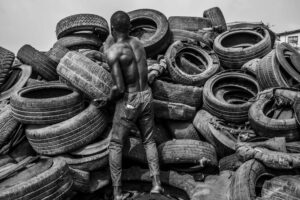
The work of a vulcaniser is not unlike that of a surgeon, says the Nigerian photographer Andrew Esiebo. Armed with precision tools, vulcanisers across Nigeria extend the lives of tyres otherwise destined for the scrap heap.
“Vulcanisers are like doctors for tyres because the way they work is like surgery,” says Esiebo, who has chronicled how used tyres are being repurposed in Lagos in a photography series exhibited as part of the British Academy-funded Pneuma-City project.
Esiebo’s work shows repurposed tyres scattered across the city, where they are used as flower pots, football goalposts, punch bags, makeshift tables, swings in a park and even seating in trendy bars. A company in Nigeria, he says, is recycling waste tyres to become floor tiles for a playground.
Esiebo’s photos are shown in the headquarters of the vulcanisers’ association in the Lagos neighbourhood of Mushin. The association’s motto is “no tyre, no movement”.
The photos are simultaneously being exhibited in seven vulcaniser workshops across the city, curated by the Lisbon-based Inês Vallee.
“It was a way of pushing photography beyond the conventional space,” Esiebo says.
A freelance photographer based in Lagos, Esiebo documents the rapid development of urban Nigeria. He started shooting the project in 2019 and continued until 2023.
Vulcanisers play “an essential role” in prolonging a tyre’s life in a country with a high cost of living, where “changing a tyre is not always easy”, Esiebo says. Lagos is a city of 20 million people, with roughly 2m cars on its roads.
Scrap tyres are a global problem, with some western countries dumping them in developing nations such as India in a phenomenon dubbed as “waste colonialism”.
Dr David Garbin, from the University of Kent, is intrigued by the imported old European tyres (known as tokunbo) getting a second life in Lagos. Many get discarded and rescued by artists, he says, whose sculptures sometimes are acquired by galleries in Europe.
